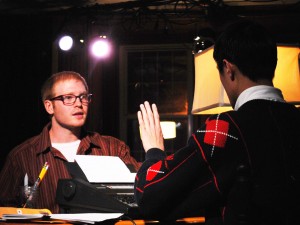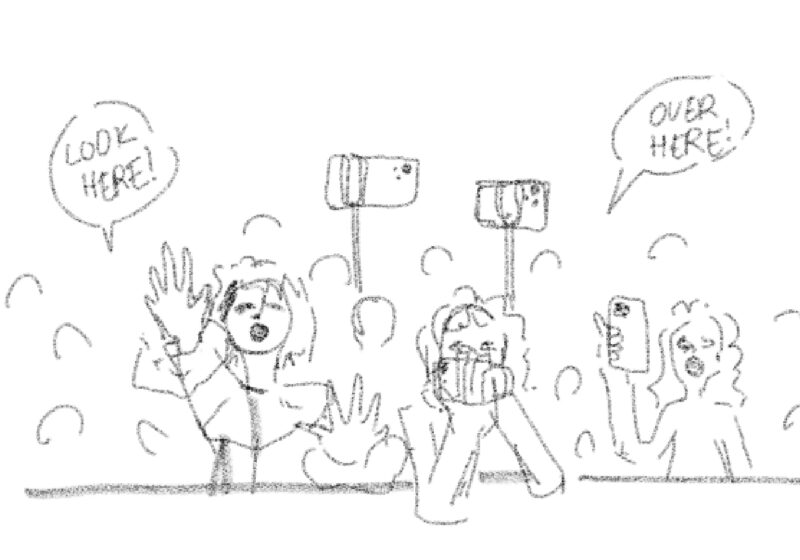One room, five characters, suspenseful music, meaningful looks and long, dramatic pauses. The conditions for and characteristics of a typical thriller remain predictable and exaggerated through the ages. “Deathtrap: A Thriller in Two Acts,” was performed by TOOP from Thursday, April 5 to Sunday, April 8. Written by Ira Levin, an American author, dramatist and songwriter, it seems no different at first, and upholds the traditional markers of the high-tension genre throughout the course of the action onstage. However, just when it seems that the plot reveals itself in its most straightforward and transparent form, “Deathtrap” does precisely as its title indicates and pits the audience in a trap, leading it to believe that the conflict resolves by the end of Act 1.
TOOP’s rendition of the play, directed by freshman Devin Goodman, begins as the lights come up on Sidney Bruhl, played by senior Raymond Liang, a “has-been” playwright who had a few successes in his day, but now sits at his desk, stewing over a well-written work by a former student, wallowing in jealousy. Through his suggestive dialogue we soon discover that Bruhl’s writing may have affected him more than by just earning him a sizeable paycheck.
“Committing murder opens one up to the idea of real murder,” he states, warning the audience that he should not be trusted.
Through his scheming, Bruhl lures his former tutee, Clifford Anderson, played by senior Charlie Edwards, to his home under the pretense of helping him revise the play. A discussion over some ginger ale reveals Bruhl’s clearly sinister intentions, which heightens the nerves of his already high-strung wife, Myra, played by junior Liz Reidman, to the extreme, as she watches and waits from nearby.
Throughout the building tension of the act, however, Levin’s clever dialogue utilizes erratic humor, disrupting the suspense of the scene. The unexpected juxtaposition of truly hilarious interactions between characters and the solemn and menacing insinuations Sidney makes help to create a dynamic play that incorporates aspects of both comedy and thriller. While the integration of these two genres produces an intriguing work, it leaves the audience feeling slightly confused.
For instance, as Sidney offers to let Cliff try on a pair of genuine Houdini trick handcuffs from his collection of antique weapons, Myra berates him, believing him to be in the act of ensnaring Cliff to murder him. Yet, Sidney drolly responds, “Myra, I’m sure Clifford isn’t the type of person who would steal another person’s idea,” in reference to a play he tells Cliff he is “working on.” The over-the-top manner in which Liang delivers his lines as Sidney cannot help but draws laughs from the audience, but, subconsciously, it recognizes that Sidney’s threats are real, which stirs up feelings of alarm and hilarity simultaneously.
The scene climaxes when Sidney finally breaks into murderous territory and strangles Cliff with one of his antique ropes, hung upon his wall with the rest of his collection of weapons. An overwrought Myra declares she wants Sidney to leave within a month because she cannot trust him any longer. After Helga Ten Dorp, played by freshman Kiki Zatas a zany psychic, makes a timely appearance to predict Myra’s “pain” (that she reiterates endlessly) and Sidney gets attacked by a man in boots (Cliff), Cliff resurfaces “from the dead,” as it would seem, to “kill” Sidney with a hammer.
As a result, Myra has a heart attack and dies. Immediately after this upheaval, Sidney rises from behind the couch where he was attacked, fit for action, revealing that Cliff and Sidney were in cahoots all along. They exchange a passionate kiss and, ultimately, close the act when Cliff throws out a nonchalant “ciao” as he walks out the door. Thus, “Deathtrap” begins its twists and turns, enticing us to believe one thing, only to make fools of us by uncovering the opposite to be true.
The games continue to become more complex as the second act plays out, in which all the characters die by the play’s end, another trap which was laid to catch the audience off guard.
All the actors maintained a vivacious energy that helped to propel the plot along. From Riedman’s hyper mannerisms and nervous tendencies as Myra to junior Arturo Spica’s bland, monotone deliverance of the character Porter Pilgram’s lines such as, “I love this room” (which could as easily have meant, “Your face nauseates me” by the tone he used), each actor embodied his or her character wholeheartedly with conviction. As Helga Ten Dorp, Zayas added a wild and exotically flavored comedy that filled the room with her bold presence. Edwards did an excellent job of transitioning from the naïve, helpful Cliff to a malicious man called to desperate actions by his desire for success.
Overall, Liang glowed as both the comedic and dramatic highlight of the evening. His handling of transitions between melodrama and comedy were smooth and effortless. In Act 1 when Myra and Cliff both panic because Sidney cannot find the keys to his Houdini handcuffs to free Cliff, Cliff implores Sidney, “Would you go on looking for the key?” Liang, as Bruhl, replies, “Certainly” in the most unenthused, prolonged drawl possible, he concurrently turns his head at the pace of a snail to aimlessly look about the room. Eventually he turns toward the revolver hanging in his collection on the wall and lifts it up, which to the audience seems like a completely outrageous location for a key to be misplaced. However, much to its dismay, Sidney indeed recovers the key here, leaving the audience to mull over its own perplexed laughter.
Apart from admirable acting and a mix of comedy and suspenseful drama, another interesting element of TOOP’s production was the sound design. Between scenes and during particularly exciting moments, parts of Vivaldi’s “Four Seasons” in Act 1 and Philip Glass’ “String Concerto” in Act 2, were paired with the clacking of a typewriter for background music by sound designer junior Adam Lanman. During the most dramatic moments, Lanman explained that he shifted the recording down one and a half semitones, in order to create a darker, tenser sound. This truly accentuated the friction demonstrated onstage between actors and contributed a great deal to the production as a whole.
With “Deathtrap,” TOOP proves, yet again, that good theater at UR can be found in places other than Todd Union. The work of all involved in the production clearly shows in the finished product in a rewarding way. As TOOP continues to grow and evolve, it becomes increasingly evident that there is much to look forward to in their repertoire in upcoming semesters.
Dickerson is a member of the class of 2012.





